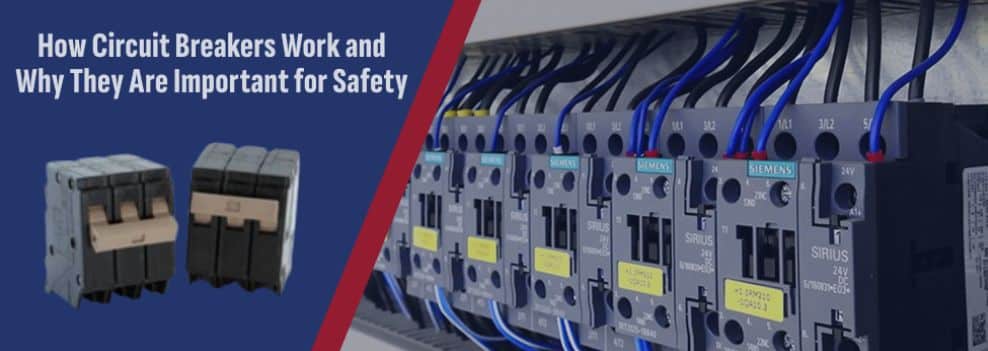
Electrical panels serve as the hub of electric supply and management in residential and commercial buildings. They are crucial in maintaining the flow of electricity and ensuring safe and efficient power distribution. This can be done using various components, and the main breaker is one among them. Popularly called circuit breakers, they monitor and control the electricity entering the system. They trip, cutting off the power in the event of overloads and short circuits, ensuring the electrical systems’ safety and longevity. Is that all? Are you intrigued to know more about these circuit breakers? If yes, continue to read this post.
Understanding Main Circuit Breakers
Main circuit breakers are crucial components of any electrical panel. They are the central point for controlling and protecting the entire electrical system. Often referred to as the first line of defense, these breakers can shield the device or system from power surges, overloads, and short circuits. Unlike branch circuit breakers, which protect specific circuits within the electrical panel, the main circuit breaker oversees the entire system. It can simultaneously cut off power to all circuits in case of a major issue. This broader scope of protection makes the main breaker vital for overall electrical safety.
How Does a Main Circuit Breaker Work?
Circuit breakers work by disconnecting the entire electrical supply to the panel, preventing damage to the wiring and reducing fire risks. Here is a quick overview of how it works.
In Normal Operation:
- Electricity from the utility line enters the main breaker before being distributed to individual circuit breakers.
- When turned on, the main breaker allows current to flow into the electrical panel, energizing all the circuits.
- Each branch circuit breaker in the panel regulates and protects its designated circuit.
In Overload or Fault Detection:
- Overload: The thermal trip mechanism activates when the system draws more current than its specific limit. This happens gradually based on how much the current exceeds the rating.
- Short Circuit: A sudden surge of current causes the magnetic trip mechanism to trip the breaker instantly. Once tripped, the breaker cuts off all power to the panel, halting electricity flow to the circuits.
Nowadays, there are smart circuit breakers that come with sensors and memory to store electrical data. They can be connected to the internet and allow remote monitoring through smartphones or laptops.
Components of a Main Breaker Switch
A main breaker panel or switch comprises several components, and here are some of them.
- Switch Lever: The switch lever is the manual control for the main breaker, allowing the user to turn the electrical supply on or off as needed. It serves as a direct, visible means of disconnecting power to the entire electrical panel. For example, during maintenance or emergencies, flipping the lever to the “off” position ensures no electricity flows into the system.
- Circuit Mechanism: This internal system detects faults like overloads or short circuits and automatically trips the breaker to interrupt the power supply. It acts as a fail-safe, ensuring that if something goes wrong in the electrical system, power is cut off quickly to protect the wiring and connected devices from damage.
- Contacts: They are the metal components inside the breaker that physically open or close to allow or stop the flow of electricity. When the main breaker is in the “on” position, the contacts are closed, forming a complete circuit that permits current to pass through. In the “off” or tripped state, the contacts open, breaking the circuit and stopping the flow of electricity.
- Thermal and Magnetic Tripping Mechanisms: The main breaker uses two distinct mechanisms—thermal and magnetic—to detect and respond to different types of electrical faults.
- Thermal Trip: This mechanism responds to sustained overcurrent by using a bimetallic strip that bends when heated by excess current. The bending triggers the breaker to trip, providing a slower response to allow temporary surges to subside but reliably cutting power if the overcurrent persists.
- Magnetic Trip: This mechanism reacts instantly to short circuits or severe current surges. An electromagnet generates a magnetic field that trips the breaker immediately, protecting the system from damage and fire risks.
How to Reset the Main Breaker?
Here are some steps to reset the main breakers.
Turning the Main Breaker Off and Then On
- After tripping, the main breaker typically stays in a neutral position. Push it completely to the “off” position first to reset the mechanism, then flip it back to “on” to restore power.
- This ensures the breaker re-engages properly and electricity flows back to the panel.
Identifying and Resolving the Cause Before Resetting
- First determine why the breaker tripped and resolve the issue.
- Resetting without addressing the problem may lead to repeated trips or system damage.
Safety Precautions During Resetting
- Keep hands dry and stand on a non-conductive surface, like a rubber mat, to avoid electric shock.
- If the breaker repeatedly trips or you notice sparks, smoke, or burning smells, contact an electrician instead of resetting. Till then, keep the breaker in an “off” mode.
Final Checks After Resetting
- Once the circuit breaker is reset, ensure circuits function properly and watch for signs of unresolved issues, like flickering lights or frequent trips.
- Address any anomalies promptly to maintain safety.
Do you want a circuit breaker box for your next application or to ensure safety in the existing setup? If yes, consulting a reliable player in this segment benefits in many ways. North America Phase Converter offers high-quality circuit breakers to fulfill your needs. Contact our team today or visit the website for more information.

Leave A Comment